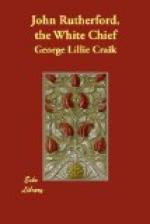Much of the land, both in the valleys and on the brows of the hills, is covered by groves of majestic pine, which are nearly impervious, from the thick underwood that has rushed up everywhere in the spaces between the trees; and where there is no wood, the prevailing plant is a fern, which rises generally to the height of six or seven feet.
Along the skirts of the woodlands flow numerous rivers, which intersect the country in all directions, and several of which are navigable for miles up by ships of considerable burthen. Various lines of communication are in this way established between the opposite coasts of the northern island; while some of the minor streams, that rush down to the sea through the more precipitous ravines, are interrupted in their course by magnificent cataracts, which give additional effect to the other features of sublimity and romantic beauty by which the country is so distinguished. Many of the rocks on the coast are perforated, a circumstance which proceeds from their formation.
The quality of the soil of this country may be best estimated from the profuse vegetation with which the greater part of it is clothed, and the extraordinary vigour which characterizes the growth of most of its productions. The botany of New Zealand has as yet been very imperfectly investigated, a very small portion of the native plants having been either classified or enumerated. From the partial researches, however, that have been made by the scientific gentlemen attached to Cook’s expeditions, and subsequent visitors, there can be no doubt that the country is rich both in new and valuable herbs, plants, and trees as well as admirably adapted for the cultivation of many of the most useful among the vegetable possessions of other parts of the world.
Rutherford, we have seen, mentions the existence of cultivated land in the neighbourhood of the village to which he was last conveyed. The New Zealanders had made considerable advances in agriculture even before Cook visited the country; and that navigator mentions particularly, in the narrative of his first voyage, the numerous patches of ground which he observed all along the east coast in a state of cultivation. Speaking of the very neighbourhood of the place at which the crew of the “Agnes” were made prisoners, he says:—“Banks saw some of their plantations, where the ground was as well broken down and tilled as even in the gardens of the most curious people among us. In these spots were sweet potatoes, coccos or eddas, which are well known and much esteemed both in the East and West Indies, and some gourds. The sweet potatoes were placed in small hills, some ranged in rows, and others in quincunx, all laid by a line with the greatest regularity. The coccos were planted upon flat land, but none of them yet (it was about the end of October) appeared above ground; and the gourds were set in small hollows, or dishes, much as in England. These plantations were of different extent, from one or two acres to ten. Taken together, there appeared to be from one hundred and fifty to two hundred acres in cultivation in the whole bay, though we never saw a hundred people. Each district was fenced in, generally with reeds, which were placed so close together that there was scarcely room for a mouse to creep between.”




